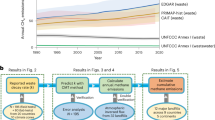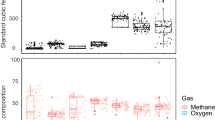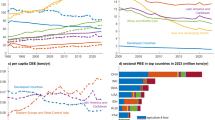Abstract
Solid waste in landfills continuously emits methane, which has become the third-largest anthropogenic source of methane emissions globally. The methane emissions from landfills exhibit substantial variability due to factors such as waste management practices and climatic conditions. Here we assessed methane emissions from 102 high-emitting landfills worldwide under different management strategies and climate conditions using 5 years of satellite observations. We find that, for these sites, total methane emissions from open dumps are underestimated by a factor of 5.3 ± 0.3 in the EDGAR v8.0 inventory. Transforming open dumpsites worldwide into sanitary landfills, while diverting organic waste to composters and biodigesters, can decrease methane emissions by 80% (60–89%), offering a mitigation potential of 760 (570–850) Mt CO2e annually. These results highlight that prioritizing improved waste management in developing countries, supported by economic and technological measures, represents one of the most effective strategies for mitigating methane emissions from the solid waste sector.
This is a preview of subscription content, access via your institution
Access options
Access Nature and 54 other Nature Portfolio journals
Get Nature+, our best-value online-access subscription
$32.99 / 30 days
cancel any time
Subscribe to this journal
Receive 12 print issues and online access
$259.00 per year
only $21.58 per issue
Buy this article
- Purchase on SpringerLink
- Instant access to full article PDF
Prices may be subject to local taxes which are calculated during checkout




Similar content being viewed by others
Data availability
The plume images detected in this study are available via Figshare at https://doi.org/10.6084/m9.figshare.29247518.v2 (ref. 59). Meteorological reanalysis data, including 10-m wind speed, temperature, humidity and atmospheric pressure, can be obtained from the Copernicus Climate Change Service (C3S) (2017): ERA5, the fifth-generation ECMWF global climate atmospheric reanalysis, available through the Copernicus Climate Data Store (CDS) at https://cds.climate.copernicus.eu. Information on organic waste addition in landfills across 330 cities globally can be found in the ‘What a Waste Global Database’ at https://datacatalog.worldbank.org/search/dataset/0039597. TROPOMI data (S5P L2 CH4 OFFLINE) are available daily via the Copernicus Open Access Hub at https://scihub.copernicus.eu. EDGAR v8.0 data are available at https://edgar.jrc.ec.europa.eu/dataset_ghg80. The US Environmental Protection Agency’s GHGRP inventory is available at https://ghgdata.epa.gov. US airborne measurement data are available via the Carbon Mapper website at https://data.carbonmapper.org. Source data are provided with this paper.
Code availability
The detailed programming codes used in this study arre available via CodeOcean at https://codeocean.com/capsule/5716215/tree/v4 (ref. 60).
References
Global Waste Management Outlook 2024: Beyond an Age of Waste, Turning Rubbish into a Resource (International Solid Waste Association, 2024).
Saunois, M. et al. The global methane budget 2000–2017. Earth Syst. Sci. Data 12, 1561–1623 (2020).
Ruane, A. C. Synthesis Report of the IPCC Sixth Assessment Report (AR6) (Intergovernmental Panel on Climate Change, 2024).
Kaza, S., Yao, L., Bhada-Tata, P. & Van Woerden, F. What a Waste 2.0: A Global Snapshot of Solid Waste Management to 2050 (World Bank Publications, 2018).
Global Non-CO2 Greenhouse Gas Emission Projections & Mitigation 2015–2050 67–71 (Environmental Protection Agency, Office of Atmospheric Programs (6207A), 2019).
Wang, Y. et al. Methane emissions from landfills differentially underestimated worldwide. Nat. Sustain. 7, 496–507 (2024).
Cusworth, D. H. et al. Using remote sensing to detect, validate, and quantify methane emissions from California solid waste operations. Environ. Res. Lett. https://doi.org/10.1088/1748-9326/ab7b99 (2020).
Bogner, J. E., Spokas, K. A. & Chanton, J. P. Seasonal greenhouse gas emissions (methane, carbon dioxide, nitrous oxide) from engineered landfills: daily, intermediate, and final California cover soils. J. Environ. Qual. 40, 1010–1020 (2011).
Spokas, K. et al. From California dreaming to California data: Challenging historic models for landfill CH4 emissions. Elementa Sci. Anthrop. https://doi.org/10.12952/journal.elementa.000051 (2015).
Mønster, J., Kjeldsen, P. & Scheutz, C. Methodologies for measuring fugitive methane emissions from landfills—a review. Waste Manag. 87, 835–859 (2019).
Thompson, S., Sawyer, J., Bonam, R. & Valdivia, J. Building a better methane generation model: validating models with methane recovery rates from 35 Canadian landfills. Waste Manag. 29, 2085–2091 (2009).
Yousuf, T. B. & Rahman, M. M. Transforming an open dump into a sanitary landfill: a development effort in waste management. J. Mater. Cycles Waste Manag. 11, 277–283 (2009).
Cusworth, D. H. et al. Quantifying methane emissions from United States landfills. Science 383, 1499–1504 (2024).
Duren, R. M. et al. California’s methane super-emitters. Nature 575, 180–184 (2019).
Irakulis-Loitxate, I. et al. Satellite-based survey of extreme methane emissions in the Permian basin. Sci. Adv. https://doi.org/10.1126/sciadv.abf4507 (2021).
Guanter, L. et al. Mapping methane point emissions with the PRISMA spaceborne imaging spectrometer. Remote Sens. Environ. https://doi.org/10.1016/j.rse.2021.112671 (2021).
Jacob, D. J. et al. Quantifying methane emissions from the global scale down to point sources using satellite observations of atmospheric methane. Atmos. Chem. Phys. 22, 9617–9646 (2022).
Maasakkers, J. D. et al. Using satellites to uncover large methane emissions from landfills. Sci. Adv. https://doi.org/10.1126/sciadv.abn9683 (2022).
Funk, C. C., Theiler, J., Roberts, D. A. & Borel, C. C. Clustering to improve matched filter detection of weak gas plumes in hyperspectral thermal imagery. IEEE Trans. Geosci. Remote Sens. 39, 1410–1420 (2001).
Varon, D. J. et al. Quantifying methane point sources from fine-scale satellite observations of atmospheric methane plumes. Atmos. Meas. Tech. 11, 5673–5686 (2018).
Frankenberg, C. et al. Airborne methane remote measurements reveal heavy-tail flux distribution in Four Corners region. Proc. Natl Acad. Sci. USA 113, 9734–9739 (2016).
Prakash, O. et al. Culture-based and culture-independent approach for the study of the methanogens and obligate anaerobes from different landfill sites. Front. Microbiol. https://doi.org/10.3389/fmicb.2023.1273037 (2024).
Nayahi, N. T., Ou, B. L., Liu, Y. Y. & Janjaroen, D. Municipal solid waste sanitary and open landfills: contrasting sources of microplastics and its fate in their respective treatment systems. J. Clean. Prod. https://doi.org/10.1016/j.jclepro.2022.135095 (2022).
Cusworth, D. H. et al. Intermittency of large methane emitters in the Permian Basin. Environ. Sci. Technol. Lett. 8, 567–573 (2021).
Cusworth, D. H. et al. Strong methane point sources contribute a disproportionate fraction of total emissions across multiple basins in the United States. Proc. Natl Acad. Sci. USA https://doi.org/10.1073/pnas.2202338119 (2022).
Aghdam, E. F., Scheutz, C. & Kjeldsen, P. Impact of meteorological parameters on extracted landfill gas composition and flow. Waste Manag. 87, 905–914 (2019).
Herath, P. L., Buddhima, S., Gunathilake, B. M., Jayawardana, D. T. & Bandara, N. Annual fluctuation of gas concentration within the landfill surface layer in a tropical climate: a case study of a municipal wasteyard. Environ. Qual. Manag. 33, 321–330 (2023).
Kissas, K., Ibrom, A., Kjeldsen, P. & Scheutz, C. Methane emission dynamics from a Danish landfill: the effect of changes in barometric pressure. Waste Manag. 138, 234–242 (2022).
Czepiel, P. M. et al. The influence of atmospheric pressure on landfill methane emissions. Waste Manag. 23, 593–598 (2003).
Czepiel, P., Mosher, B., Crill, P. & Harriss, R. Quantifying the effect of oxidation on landfill methane emissions. J. Geophys. Res. Atmos. 101, 16721–16729 (1996).
Eggleston, H., Buendia, L., Miwa, K., Ngara, T. & Tanabe, K. 2006 IPCC Guidelines for National Greenhouse Gas Inventories (IGES, 2006).
Sadavarte, P. et al. Methane emissions from superemitting coal mines in Australia quantified using TROPOMI satellite observations. Environ. Sci. Technol. 55, 16573–16580 (2021).
Crippa, M. et al. GHG Emissions of All World Countries (Publications Office of the European Union, Luxembourg, 2024); https://doi.org/10.2760/4002897
Crippa, M. et al. Insights into the spatial distribution of global, national, and subnational greenhouse gas emissions in the Emissions Database for Global Atmospheric Research (EDGAR v8. 0). Earth Syst. Sci. Data 16, 2811–2830 (2024).
Tellinghuisen, J. Statistical error propagation. J. Phys. Chem. A 105, 3917–3921 (2001).
Guha, A. et al. Assessment of regional methane emission inventories through airborne quantification in the San Francisco Bay Area. Environ. Sci. Technol. 54, 9254–9264 (2020).
Facility Level Information on Greenhouse Gases Tool (FLIGHT). US Environmental Protection Agency https://ghgdata.epa.gov/ghgp/main.do (2023).
Nordahl, S. L. Comparative life-cycle assessment of anaerobic digestion of municipal solid waste at zero waste energy development company in San Jose, California. Master’s thesis (Univ. of California, Berkeley, 2018).
Crippa, M. et al. High resolution temporal profiles in the Emissions Database for Global Atmospheric Research. Sci. Data 7, 121 (2020).
Li, H. et al. Seasonal CH4 and CO2 effluxes in a final covered landfill site in Beijing, China. Sci. Total Environ. 725, 138355 (2020).
Asadi, M., Yuen, S. T., Bogner, J., Chen, D. & Lightbody, P. Seasonal variation of methane emissions from two landfills in Australia. In 7th International Congress on Environmental Geotechnics: iceg2014 1355–1360 (Engineers Australia, 2014).
Chai, X., Tonjes, D. J. & Mahajan, D. Methane emissions as energy reservoir: context, scope, causes and mitigation strategies. Prog. Energy Combust. Sci. 56, 33–70 (2016).
Wang, Y., Yan, Y., Chen, G., Zuo, J. & Du, H. Effective approaches to reduce greenhouse gas emissions from waste to energy process: a China study. Resour. Conserv. Recycl. 104, 103–108 (2015).
Mukherjee, C., Denney, J., Mbonimpa, E. G., Slagley, J. & Bhowmik, R. A review on municipal solid waste-to-energy trends in the USA. Renew. Sustain. Energy Rev. 119, 109512 (2020).
Tadesse, A. & Lee, J. Utilization of methane from municipal solid waste landfills. Environ. Eng. Res. 29, 230166-230160 (2023).
Veefkind, J. P. et al. TROPOMI on the ESA Sentinel-5 Precursor: a GMES mission for global observations of the atmospheric composition for climate, air quality and ozone layer applications. Remote Sens. Environ. 120, 70–83 (2012).
Zhang, Y. et al. Quantifying methane emissions from the largest oil-producing basin in the United States from space. Sci. Adv. 6, eaaz5120 (2020).
Rohrschneider, R. R. et al. The MethaneSAT mission. In 35th Annual Small Satellite Conference Proceedings 1–7 (Utah State University, 2021).
Free vector and raster map data. Natural Earth http://www.naturalearthdata.com (2024).
Google Earth. Imagery © 2024 Maxar Technologies. Google Earth https://earth.google.com/web/ (2024).
Cogliati, S. et al. The PRISMA imaging spectroscopy mission: overview and first performance analysis. Remote Sens. Environ. 262, 112499 (2021).
Thompson, D. et al. Space‐based remote imaging spectroscopy of the Aliso Canyon CH4 superemitter. Geophys. Res. Lett. 43, 6571–6578 (2016).
Berk, A. et al. MODTRAN® 6: A major upgrade of the MODTRAN® radiative transfer code. In 2014 6th Workshop on Hyperspectral Image and Signal Processing: Evolution in Remote Sensing (WHISPERS) 1–4 (IEEE, 2014).
Ayasse, A. K. et al. Evaluating the effects of surface properties on methane retrievals using a synthetic airborne visible/infrared imaging spectrometer next generation (AVIRIS-NG) image. Remote Sens. Environ. 215, 386–397 (2018).
Varon, D. J. et al. Satellite discovery of anomalously large methane point sources from oil/gas production. Geophys. Res. Lett. 46, 13507–13516 (2019).
Cusworth, D. H. et al. Detecting high-emitting methane sources in oil/gas fields using satellite observations. Atmos. Chem. Phys. 18, 16885–16896 (2018).
Ayasse, A. K. et al. Methane remote sensing and emission quantification of offshore shallow water oil and gas platforms in the Gulf of Mexico. Environ. Res. Lett. https://doi.org/10.1088/1748-9326/ac8566 (2022).
Varon, D. J., Jacob, D. J., Jervis, D. & McKeever, J. Quantifying time-averaged methane emissions from individual coal mine vents with GHGSat-D satellite observations. Environ. Sci. Technol. 54, 10246–10253 (2020).
Tong, H. Figures_NCLIM-24113152C.zip. Figshare https://doi.org/10.6084/m9.figshare.29247518 (2025).
Tong, H. Significant reduction of methane emissions through improved landfill management [source code]. CodeOcean https://doi.org/10.24433/CO.8032459.v4 (2025).
Acknowledgements
T.C. acknowledges support from the National Key Research and Development Program of China (grant no. 2022YFB3904801). We thank the Italian Space Agency for the free PRISMA data used in this study.
Author information
Authors and Affiliations
Contributions
H.T. performed most of the data analysis, made figures and wrote the first draft with support from T.C. and others. T.C. designed, managed and obtained funding for the project. X.L. and X.Y. helped calculate methane emissions and drafted some of the Methods section. T.C. H.Z., X.Y., D.F. and T.T. assisted in collecting, analysing and illustrating the data. T.C. drafted the introduction and performed some of the literature review. All authors edited the paper and approved its submission.
Corresponding author
Ethics declarations
Competing interests
The authors declare no competing interests.
Peer review
Peer review information
Nature Climate Change thanks Rona Thompson, Ke Yin and the other, anonymous, reviewer for their contribution to the peer review of this work.
Additional information
Publisher’s note Springer Nature remains neutral with regard to jurisdictional claims in published maps and institutional affiliations.
Extended data
Extended Data Fig. 1 Typical Landfill True Color Satellite Images.
a, Algeria, b, Mexico, c, Iran, d, Brazil, e, United States, f, China. a–c are open dumpsites, while d–f are sanitary landfills. Credit: background satellite images, Google Earth Imagery © 2024 Maxar Technologies.
Extended Data Fig. 2 Distribution of methane emissions from the U.S. solid waste sector.
Quantified by the Next-Generation Airborne Visible/Infrared Imaging Spectrometer (AVIRIS-NG) and the Global Airborne Observatory (GAO) airborne campaigns between September 2016 and June 2024(10 kg h−1 detection limit). To derive emission rates per overpass from airborne data, individual plumes detected within the same landfill were spatially clustered to represent a single emission event. Data were provided by Carbon Mapper. Figure adapted with permission from ref. 13, AAAS.
Extended Data Fig. 3 Relationship Between Average Methane Emission Flux and Food Organic Content in Landfills.
Box plots show the median (solid line), the 25th and 75th percentiles (box edges), and whiskers extend to the most extreme data points within 1.5× the interquartile range.
Extended Data Fig. 4 Comparison of Total Annual Methane Emissions from Landfills Detected by PRISMA with the EDGAR v8.0 Global Inventory (Classified by Country).
Blue bars represent sanitary landfills, while orange bars represent open landfills. The shaded area indicates the total annual average methane emissions recorded by EDGAR v8.0 from 2019 to 2022 for these landfills. The numbers inside the bars represent the count of each landfill type in the statistics, and the numbers above the bars indicate the total number of both landfill types. Black error bars represent ±1 SD around the mean emission estimate, calculated across all landfills within each country.
Extended Data Fig. 5 Example Methane Emission Rates from US Landfills.
The first three bars on the left represent estimates from different inventories—BAAQMD (blue), EDGAR (orange), and US EPA (green). The bar on the right represents PRISMA measurements (red). The numbers within the red bars indicate the number of effective measurements for each landfill. Black error bars represent ±1 SD around the mean (or estimated measurement uncertainty for single-retrieval cases). EDGAR data from ref. 34, BAAQMD data from ref. 36 and GHGRP data from ref. 37.
Supplementary information
Supplementary Information
Supplementary Figs. 1–6.
Source data
Source Data Fig. 1
Information on 102 landfills.
Source Data Fig. 2
Methane plume data in TIFF format. The files contain spatial distributions of methane enhancements retrieved from hyperspectral remote sensing observations.
Source Data Fig. 3
Information on plumes.
Source Data Fig. 4
Methane emissions from surveyed landfills in developing and developed countries.
Source Data Extended Data Fig. 3
Food organic waste percentage (%) and methane emission flux for each landfill site.
Source Data Extended Data Fig. 4
Annual methane emissions from landfills monitored by PRISMA across various countries.
Source Data Extended Data Fig. 5
Comparison of methane emissions from four US landfills: PRISMA observations versus inventory reports.
Rights and permissions
Springer Nature or its licensor (e.g. a society or other partner) holds exclusive rights to this article under a publishing agreement with the author(s) or other rightsholder(s); author self-archiving of the accepted manuscript version of this article is solely governed by the terms of such publishing agreement and applicable law.
About this article
Cite this article
Tong, H., Cheng, T., Li, X. et al. Reduction of methane emissions through improved landfill management. Nat. Clim. Chang. 15, 866–872 (2025). https://doi.org/10.1038/s41558-025-02391-1
Received:
Accepted:
Published:
Issue date:
DOI: https://doi.org/10.1038/s41558-025-02391-1



